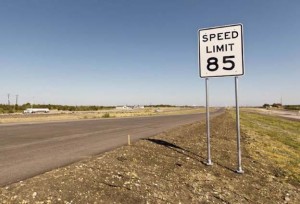With the opening of the last 41-mile stretch of a new toll road outside Austin, the Lone Star State now can lay claim to having the fastest highway in America.
Motorists can cruise along that last portion of Texas State Highway 130 at speeds of up to 85 miles per hour. The privately-operated, 91-mile toll road is the only portion of Gov. Rick Perry’s ambitious Trans Texas Corridor superhighway project to actually make it into reality.
“There are very few people that get up and say they love road construction, but I think everyone is happy when you open a road up,” the one-time presidential candidate said as he snipped a ribbon and declared the high-speed route open for traffic.
What might make residents particularly happy is the decision to waive tolls on the new stretch of SH 130 through November 11. At 15 cents a mile, motorists will then begin paying about $6.00 to travel the high-speed route which bypasses the Texas capital of Austin before merging into U.S. Interstate -10 near the town of Seguin.
Various Western states have been racing to see who might post the highest speed limit since Congress lifted restrictions a decade back, and postings of 70 and 75 have become commonplace. A separate, 50-mile portion of Texas 130 had been running at 80 miles an hour. It appears that the toll road’s operator, SH 130 Concession Co., is betting that the latest increase will help lure motorists who might otherwise stick to local roads or alternative, free highways.
That’s been a problem in California where pay-as-you-go routes in Orange County and other portions of the state have generated far less traffic – and revenue – than originally predicted.
The operator of the 91-mile Texas toll road had to pay a $100 million fee to get the right to set its own speed limit, according to news reports.
The route should help alleviate increasing congestion around the capital, which has become a mecca for high-tech firms such as computer maker Dell.
But it is just a fraction of what was originally envisioned by Gov. Perry who had hoped to have his Trans Texas Corridor developed as a high-speed, privately-financed route across the Lone Star State, a corridor that was envisioned as a link in a long-sought trade link that would connect the NAFTA nations of Canada, the U.S. and Mexico.
Efforts to push the Texas toll road through ran afoul of resistance to the idea of using the eminent domain process to seize private land that would have been needed for the route.
While there’s a strong libertarian streak in Texas, not everyone is happy about the 85 mph limit. After a number of years of declining highway deaths, preliminary numbers from the National Highway Traffic Safety Administration show the trend has reversed this year with a small increase in fatalities.
The data have yet to be finalized and it’s debatable whether increasing speed limits deserve blame. Federal regulators have been aggressively focusing their attention on the scourge of distracted driving while continuing to crack down on drunk drivers.
But while the high speed limit on SH 130 might seem a blessing for truckers who are restricted in the number of hours they can log in a single day, the American Trucking Association is, in fact, pressing Texas regulators to reduce the number.
Many trucks, it seems, have governors that won’t let them travel anywhere near 85 mph. And the fear is that the speed differential between car and truck traffic could lead to accidents.

